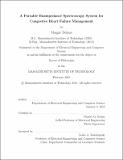| dc.contributor.advisor | Charles G. Sodini. | en_US |
| dc.contributor.author | Delano, Margaret K | en_US |
| dc.contributor.other | Massachusetts Institute of Technology. Department of Electrical Engineering and Computer Science. | en_US |
| dc.date.accessioned | 2018-05-23T15:05:46Z | |
| dc.date.available | 2018-05-23T15:05:46Z | |
| dc.date.copyright | 2018 | en_US |
| dc.date.issued | 2018 | en_US |
| dc.identifier.uri | http://hdl.handle.net/1721.1/115636 | |
| dc.description | Thesis: Ph. D., Massachusetts Institute of Technology, Department of Electrical Engineering and Computer Science, 2018. | en_US |
| dc.description | This electronic version was submitted by the student author. The certified thesis is available in the Institute Archives and Special Collections. | en_US |
| dc.description | Cataloged from student-submitted PDF version of thesis. | en_US |
| dc.description | Includes bibliographical references (pages 139-149). | en_US |
| dc.description.abstract | Congestive Heart Failure (CHF) is a chronic medical condition that causes reduced exercise tolerance, shortness of breath, and fluid buildup in the lungs, legs, and abdomen. While CHF-related mortality has reduced in recent years, this reduction has been accompanied by an increase in hospitalizations and readmissions. This thesis takes the first steps toward developing a compression sock based bioimpedance monitoring system for patients with CHF to help reduce readmission rates. The primary goals of the thesis were to better understand the calf bioimpedance measurement in a controlled environment (hemodialysis) and to develop portable hardware to perform measurements. Calf bioimpedance was measured on 17 patients undergoing hemodialysis using both a commercial measurement system and the experimental system developed in this thesis. Measured calf bioimpedance data showed that more fluid is recruited from the calf at higher ultrafiltration rates. Fluid shifts into or out of cells also depended on the ultrafiltration rate. It was also observed that patients with high calf fluid overload accumulate fluid in the calf, rather than lose it. Bioimpedance measurements were also compared between the side of the leg and back of the leg. Changes in calf bioimpedance were higher on the back in 4/7 patients measured, suggesting that ideal electrode placement depends on the individual patient. Finally, a portable bioimpedance system was developed and verified against a commercial system on the bench and during hemodialysis. The two systems measured bioimpedance changes within 2 in most cases, with outliers limited to patients with particularly low calf bioimpedance. While the relationship between calf fluid status and total fluid status is complex, there is likely utility in calf bioimpedance measurements for CHF remote monitoring. In the ideal use case, patients will start out at dry weight and gain comparable amounts of fluid compared with the fluid removed during hemodialysis. This should result in measurable calf bioimpedance changes on the same order of those measured here. Additionally, rates of both fluid accumulation and removal will be an order of magnitude slower than hemodialysis, so volume compartments should be in equilibrium, unlike immediately following hemodialysis as was measured in this thesis. | en_US |
| dc.description.statementofresponsibility | by Maggie Delano. | en_US |
| dc.format.extent | 149 pages | en_US |
| dc.language.iso | eng | en_US |
| dc.publisher | Massachusetts Institute of Technology | en_US |
| dc.rights | MIT theses are protected by copyright. They may be viewed, downloaded, or printed from this source but further reproduction or distribution in any format is prohibited without written permission. | en_US |
| dc.rights.uri | http://dspace.mit.edu/handle/1721.1/7582 | en_US |
| dc.subject | Electrical Engineering and Computer Science. | en_US |
| dc.title | A portable bioimpedance spectroscopy system for congestive heart failure management | en_US |
| dc.type | Thesis | en_US |
| dc.description.degree | Ph. D. | en_US |
| dc.contributor.department | Massachusetts Institute of Technology. Department of Electrical Engineering and Computer Science | |
| dc.identifier.oclc | 1036987523 | en_US |
